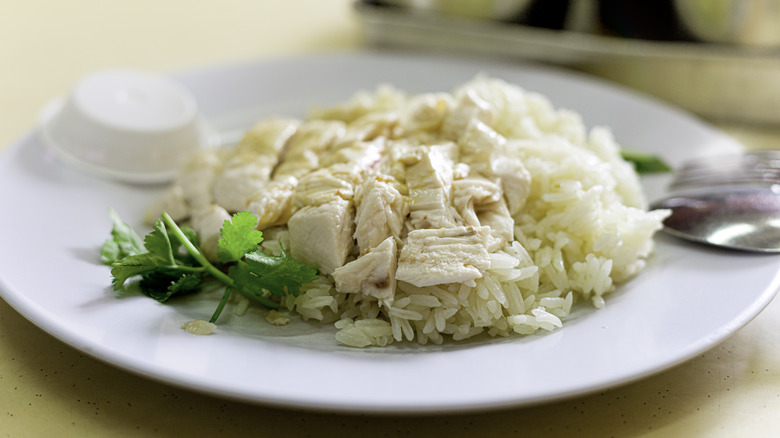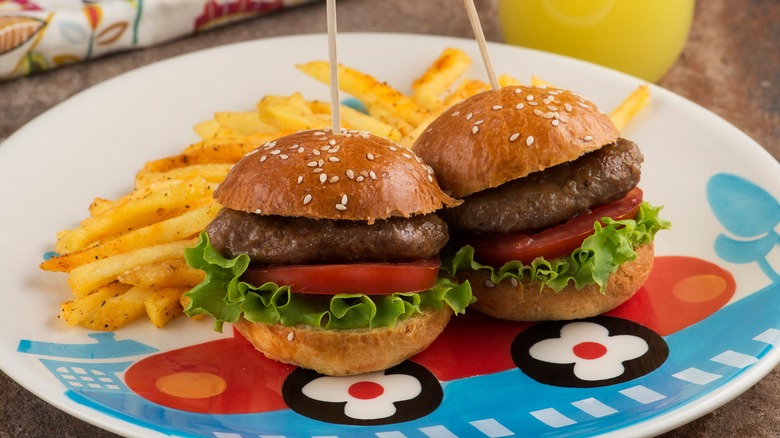History's Earliest Restaurant Children's Menus Looked Remarkably Different
Every parent can tell you that deciding to dine out with your kids requires running down a set of mental questions — ones that never needed to be considered before the little darlings came along. Pre-children, all you needed to know was the restaurant, its location, and what time to be there (because a nine o'clock reservation on a Tuesday at the city's hottest new restaurant was completely thinkable). With kids, however, parents want to know if there are booster seats, if lids and straws come with beverages, and — most importantly — if there is a children's menu.
Restaurant children's menus usually offer low-cost food options that little Johnny or Sue will eat without complaint. You know the ones — mac and cheese, chicken strips, pizza, a grilled cheese, perhaps with a side of boiled broccoli (that will remain untouched), and a dessert. Apparently, it's not until a child is 13 years old that they would even deign to order from the adult menu. While having separate menus for little ones is nothing new, the dishes offered in them couldn't be more different from what the nation's earliest kid's menus looked like. In fact, some of the items you'd find on any such menu from 100 years ago would most likely be on an adult menu today, indicating how different our children's tastes have become.
No chicken nuggets
Mental Floss says that dining out with children was a rare thing prior to the Prohibition Era. But when restaurants were faced with lost revenue from liquor sales, they had to get creative to make ends meet. One such idea was allowing kids to join their parents for a meal out. New York City's Waldorf-Astoria hotel offered a children's menu in 1921 that included broiled lamb chops, flaked chicken with rice, and something called prune whip. Restaurant-ing Through History highlights a 1918 kid's lunch menu from a department store in Ohio that boasted cream-baked rice, a peanut butter sandwich, milk, and ice cream. Another 1927 menu from Shepard Store in Boston consisted of a poached egg with creamed spinach, a baked potato, and bread with butter.
As time went on, children's menus became a staple of dining out, and by the 1940s, many began to include colorful illustrations of toys, animals, and even comic strips to cater to children's sense of fun and wonder (via Dusty Old Thing). The site explains that it wasn't until the mid-20th century that the food items on children's menus made the shift towards the foods we see today, like chicken nuggets, hot dogs, and french fries, and this was due to the emergence of diners and fast food eateries in the 1950s.
Why the stark difference from today?
According to Slate, a book called "The Care and Feeding of Children” was first published in 1894. It was written by a pediatrician named Emmett Holt, who, for 50 years, would be the leading voice in the nation for rearing children. With no evidence to support his case, Holt claimed that children shouldn't eat things like fresh fruit, pastries, ham, or corn. Naturally, restaurants feeding children followed this advice, and America's children suffered the bland offerings. By 1946, Holt was displaced as the star children's doctor of America by Dr. Benjamin Spock, whose "Baby and Child Care" book is now on its 10th print edition, per Simon and Schuster. Backed by science and research, Dr. Spock took a much more relaxed approach to parenting in general and child nutrition in particular, concepts American parents still cling to today. This certainly didn't change the presence of children's menus, it just may have birthed the option of a fresh fruit cup alongside a kid's cheeseburger.
Not all children's menus are the same, however, especially in other countries. A 1900 menu from Paris' Restaurant Gardes includes a child's menu, which just includes a smaller portion of what is on the regular menu (via New York Public Library). Indeed, even today, very few French eateries offer kid-friendly meals — the little ones simply eat what the adults eat. In American culture, though, it appears kid's menus are here to stay.


